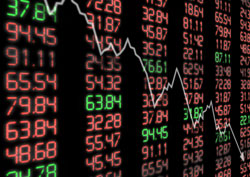The Dow plunged 1,089 points Monday on the open, prompting investors to ask us, "Will the stock market shut down today?"
You see, if markets fall far enough, circuit breakers kick in and halt trading.
Markets were spared from a circuit breaker trip today. The Dow pared losses Monday afternoon, but only after its largest one-day point decline ever on an intraday basis. Just before 1 p.m., the  Dow was down 180 points, or 1.1%. The S&P 500 was off 1.35%, and the Nasdaq was lower by 0.93%.
Dow was down 180 points, or 1.1%. The S&P 500 was off 1.35%, and the Nasdaq was lower by 0.93%.
While a circuit breaker trigger was averted Monday, market volatility will continue, and there will be more major down days ahead. Here's what has to happen for the stock market to actually shut down...
Will the Stock Market Shut Down? Turn to Rule 48
After the Dow, S&P 500, and Nasdaq futures fell at least 5% in pre-market trading Monday, the New York Stock Exchange deployed the rarely used "Rule 48" in an attempt to ensure orderly trading.
Invoking Rule 48 means designated market makers don't have to disseminate price indications before the opening bell in an effort to make it easier and faster to open stocks. It's intended for times when potentially extreme market volatility could have a floor-wide impact, according to the NYSE.
The rule was first approved by the U.S. Securities and Exchange Commission in December 2007.
To invoke Rule 48, an exchange must determine that the day's market conditions could create major disruptions. That includes anything from volatility in the previous day's session to extreme volatility in foreign markets to substantial futures action.
But that's not the only thing that can shut down the stock market. "Circuit breakers" also play a key role...
How Stock Market Circuit Breakers Work
Until 1997, the markets used a point drop rule to determine when to use circuit breakers.
That meant officials looked at how many points the markets declined, rather than the percentage of the move, to trigger circuit breakers.
Unlike Rule 48, circuit breakers halt trading for a specified length of time once a sell-off reaches a designated magnitude.
They were initiated in the wake of 1987's Black Monday. On Oct. 19, 1987, the market plummeted 509.32 points, or 22.6%, the largest one-day percentage drop in history to date. Some $500 billion was wiped out on that infamous day.
The SEC revised its circuit breaker rules in 2012. Now, market-wide circuit breakers kick in when the S&P 500 drops 7% (Level 1), 13% (Level 2), and 20% (Level 3) from the prior day's close.
A market decline that triggers a Level 1 or Level 2 circuit breaker before 3:25 p.m. will halt market-wide trading for 15 minutes. A similar market decline "at or after" 3:25 p.m. will not halt market-wide trading.
With the S&P 500 closing at 1,970 last Friday, levels to watch Monday were Level 1 at 1,832, Level 2 at 1,714, and Level 3 at 1,576.
The last time circuit breakers were tripped was Oct. 27, 1997. The Dow plunged 554 points, or 7.2%, that day. It was the worst single-day loss in the index's history up to that point.
Circuit breakers were first used in October 1989 following the Friday the 13th mini-crash. The Dow dropped 78.05 points, or 5.26%, on Oct. 13, 1989. It fell another 102.04 points, or 7.26%, on Oct. 16, 1989, for a total two-day trading decline of 12.13%.
In the aftermath of the 2010 "flash crash," the trigger for the market-wide circuit breaker was switched to the S&P 500 instead of the Dow.
While circuit breakers were not used and markets didn't shut down Monday, circuit breakers for many individual stocks were activated early in the session.
Stay informed on what's going on in the markets by following us on Twitter @moneymorning.
Protect Yourself from a Total Market Collapse: According to CIA Asymmetric Threat Advisor Jim Rickards, there are five "flashpoints" that signal the death of the U.S. dollar and a complete economic collapse in the United States. Here's how you can protect yourself, and your money, before it's too late...
Related Articles:
- NYSE: Circuit Breakers
- CNN Money: Flash Crash: Could It Happen Again?
- The Wall Street Journal: Dow Pares Losses After 1,089-Point Plunge But Still Down Sharply in Global Rout


